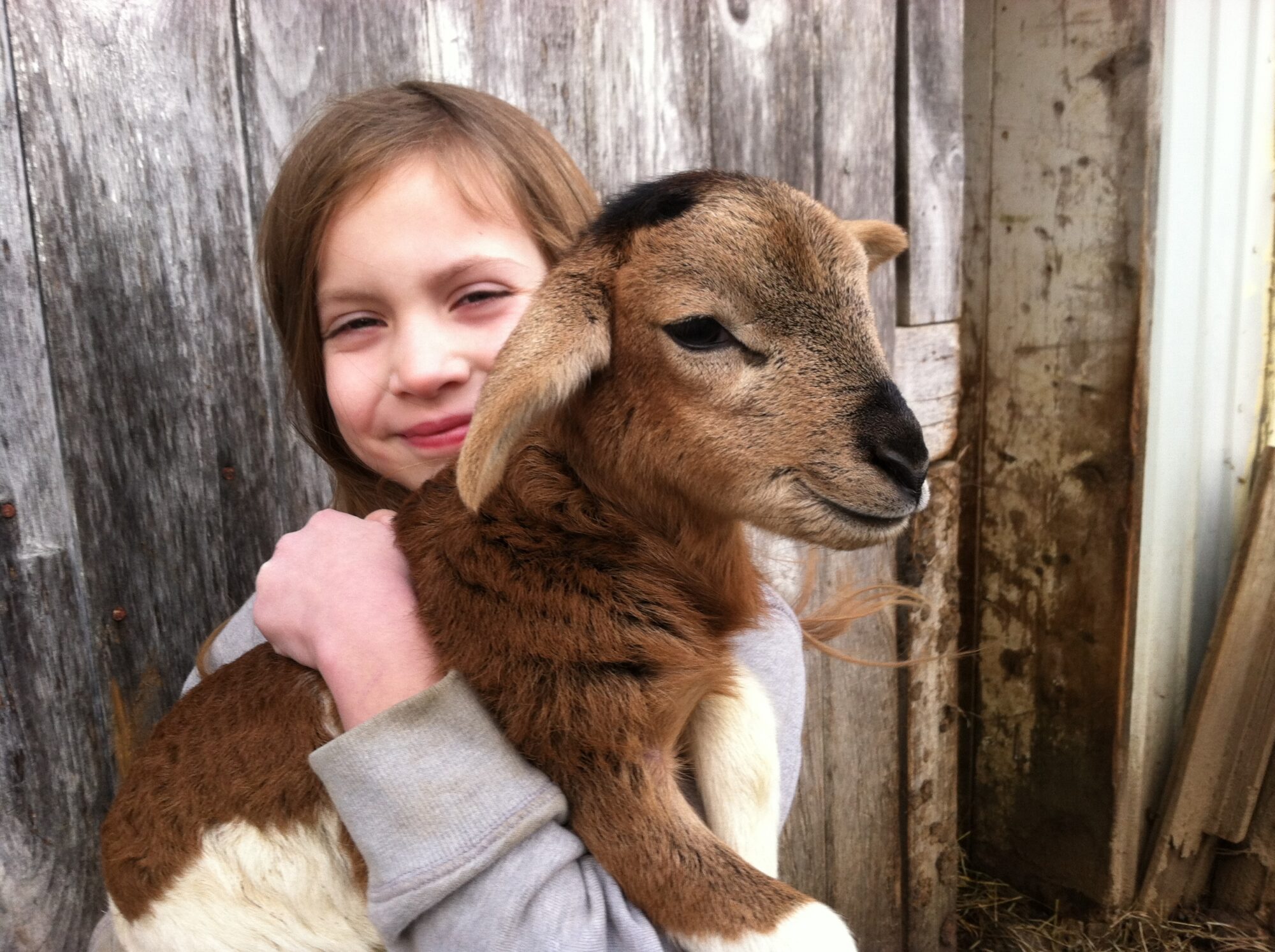Springtime on our farm is exactly what you would imagine it to be—filled with babies. We breed our goats and sheep to give birth at several points during the winter and spring, with the newest moms (often referred to as “replacement” does and ewes) giving birth at this time of year. This means baby goats and lambs are bouncing all over the barn, racing up and down, playing ‘king of the mountain’ by climbing on their un-amused mothers, and practicing butting heads like they can’t wait to grow up. There are literal piles of babies sleeping in every corner, because they love to cuddle with one another for warmth while their moms eat hay. It is such a busy, chaotic time, it’s hard to imagine how all the moms and babies keep things straight. Yet, they do. Each mom knows her baby’s call; each baby responds when Mom says it’s time to eat. They know each other’s voices, they recognize their smells. It’s an amazing thing to witness.
As magical as a barn full of baby farm animals may sound, it represents years of hard work, hard-learned lessons, and mountains of perseverance. For example, I’ve learned that first-time moms are the most challenging. Their frames are often slightly smaller and their pelvis and various ligaments are not as limber as the seasoned birthers, so they are more prone to needing assistance during birth. Even worse, their mothering instincts are all over the board. If I’ve done my homework and chosen replacement does and ewes from good mothers, I can only hope good mothering instincts will kick in. But sometimes they are not good mothers; in fact, sometimes they are terrible. Four mothers rejected their babies this season, making my busy job even harder. Finally, new moms are simply not as good at producing large volumes of milk. Again, if I’ve done my job and chosen my replacements carefully, I will have good milk producers that will quickly raise healthy, meaty babies. Called selective breeding, this is the farmer’s attempt to breed animals for specific traits. It is both a science and an art—and I have great respect for folks that do it well. My approach is nowhere near scientific and at no other time of the year is my lack of breeding expertise more apparent than in the spring.
Nutrition, of course, is of the utmost importance just before babies arrive and for the few months following their birth. About a month before her due date, a goat or sheep should be getting the best feed possible, with a free-choice, balanced mineral supplement. She shouldn’t get fat, though, because that too can cause terrible problems, including ketosis and difficulty giving birth. After having her baby, good feed and minerals continue, although she’ll be eating and drinking significantly more in order to support milk production. That all sounds well and good, but how do you make sure this proper balance is met? Since we are a small, grass-based operation, we do not work with a nutritionist nor have anyone testing our hay. Instead, I spend many hours observing our animals, feeling babies for full bellies, checking eyelids for anemia, and watching out for those that hang back during feeding time. Not working with a nutritionist is an enormous gamble, however. The past two years of drought followed by a much-too-wet summer produced very poor-quality hay here in Central New York and has made for an extremely difficult spring for many small producers. A number of small local farms experienced high levels of mid- and late-term miscarriages as a result.
This, too, is a time to be aware of any potential health problems. Moms can develop mastitis; babies can develop coccidiosis, “floppy kid” syndrome, or white muscle disease. Again, we’ve been extremely fortunate to experience very few of these problems, but that doesn’t allow me to be lax in my management. I have to watch for hot (or God forbid—cold) udders, for damaged or sore teats, weak babies, muddy butts, runny noses, even sagging ears. I have to recognize the difference between a lamb’s normal, plaintive hungry call and a weaker cry that means she isn’t getting as much milk as her husky brother. Preventing potential problems is every farmer’s first line of defense, usually in the form of clean bedding, adequate housing, fresh air, and proper nutrition. Of course, Mother Nature is often wicked and unpredictable, so the next line of defense is catching and treating health problems as early as possible.
>
“Successfully raising happy, healthy animals in a sustainable manner is infinitely more complex than diet or management style alone.”
But would I say I have it “all figured out”? Absolutely not! That barn full of rambunctious baby goats and lambs is both a joy and a sobering challenge—every day, all year long. This humbling life as a goat farmer has me truly appreciating the experienced farmers around me, whose skills in animal husbandry seem to come so naturally. These days, it seems there is so much focus on whether a farm is organic or not, or feeding genetically modified grains or not. All the while we’re missing the bigger picture: Successfully raising happy, healthy animals in a sustainable manner is infinitely more complex than diet or management style alone. You can’t learn it in a book; you can’t even get the full picture with a degree in agriculture—it takes years of doing. And good farmers seem to understand that they are never done learning.
